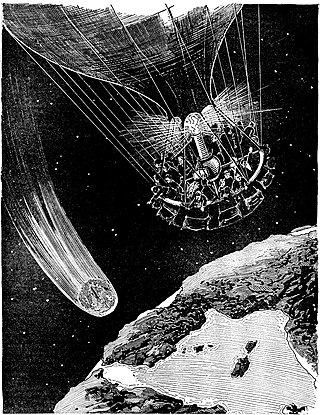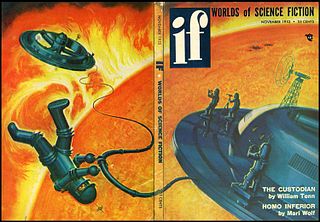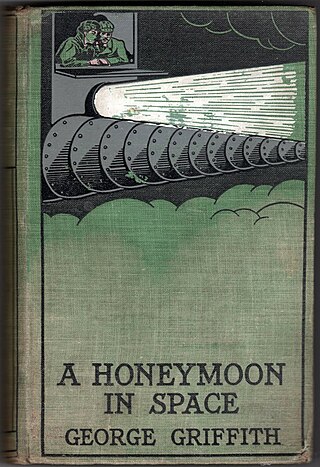
Mars, the fourth planet from the Sun, has appeared as a setting in works of fiction since at least the mid-1600s. Trends in the planet's portrayal have largely been influenced by advances in planetary science. It became the most popular celestial object in fiction in the late 1800s, when it became clear that there was no life on the Moon. The predominant genre depicting Mars at the time was utopian fiction. Around the same time, the mistaken belief that there are canals on Mars emerged and made its way into fiction, popularized by Percival Lowell's speculations of an ancient civilization having constructed them. The War of the Worlds, H. G. Wells's novel about an alien invasion of Earth by sinister Martians, was published in 1897 and went on to have a major influence on the science fiction genre.

Wonder Stories was an early American science fiction magazine which was published under several titles from 1929 to 1955. It was founded by Hugo Gernsback in 1929 after he had lost control of his first science fiction magazine, Amazing Stories, when his media company Experimenter Publishing went bankrupt. Within a few months of the bankruptcy, Gernsback launched three new magazines: Air Wonder Stories, Science Wonder Stories, and Science Wonder Quarterly.

The planet Venus has been used as a setting in fiction since before the 19th century. Its opaque cloud cover gave science fiction writers free rein to speculate on conditions at its surface—a "cosmic Rorschach test", in the words of science fiction author Stephen L. Gillett. The planet was often depicted as warmer than Earth but still habitable by humans. Depictions of Venus as a lush, verdant paradise, an oceanic planet, or fetid swampland, often inhabited by dinosaur-like beasts or other monsters, became common in early pulp science fiction, particularly between the 1930s and 1950s. Some other stories portrayed it as a desert, or invented more exotic settings. The absence of a common vision resulted in Venus not developing a coherent fictional mythology, in contrast to the image of Mars in fiction.

Jupiter, the largest planet in the Solar System, has appeared in works of fiction across several centuries. The way the planet has been depicted has evolved as more has become known about its composition; it was initially portrayed as being entirely solid, later as having a high-pressure atmosphere with a solid surface underneath, and finally as being entirely gaseous. It was a popular setting during the pulp era of science fiction. Life on the planet has variously been depicted as identical to humans, larger versions of humans, and non-human. Non-human life on Jupiter has been portrayed as primitive in some works and more advanced than humans in others.

Saturn has made appearances in fiction since the 1752 novel Micromégas by Voltaire. In the earliest depictions, it was portrayed as having a solid surface rather than its actual gaseous composition. In many of these works, the planet is inhabited by aliens that are usually portrayed as being more advanced than humans. In modern science fiction, the Saturnian atmosphere sometimes hosts floating settlements. The planet is occasionally visited by humans and its rings are sometimes mined for resources.

Pluto has appeared in fiction as a setting since shortly after its 1930 discovery, albeit infrequently. It was initially comparatively popular as it was newly discovered and thought to be the outermost object of the Solar System and made more fictional appearances than either Uranus or Neptune, though still far fewer than other planets. Alien life, sometimes intelligent life and occasionally an entire ecosphere, is a common motif in fictional depictions of Pluto. Human settlement appears only sporadically, but it is often either the starting or finishing point for a tour of the Solar System. It has variously been depicted as an originally extrasolar planet, the remnants of a destroyed planet, or entirely artificial. Its moon Charon has also appeared in a handful of works.

Asteroids have appeared in fiction since at least the late 1800s, the first one—Ceres—having been discovered in 1801. They were initially only used infrequently as writers preferred the planets as settings. The once-popular Phaëton hypothesis, which states that the asteroid belt consists of the remnants of the former fifth planet that existed in an orbit between Mars and Jupiter before somehow being destroyed, has been a recurring theme with various explanations for the planet's destruction proposed. This hypothetical former planet is in science fiction often called "Bodia" in reference to Johann Elert Bode, for whom the since-discredited Titius–Bode law that predicts the planet's existence is named.

Neptune has appeared in fiction since shortly after its 1846 discovery, albeit infrequently. It initially made appearances indirectly—e.g. through its inhabitants—rather than as a setting. The earliest stories set on Neptune itself portrayed it as a rocky planet rather than as having its actual gaseous composition; later works rectified this error. Extraterrestrial life on Neptune is uncommon in fiction, though the exceptions have ranged from humanoids to gaseous lifeforms. Neptune's largest moon Triton has also appeared in fiction, especially in the late 20th century onwards.

Uranus has been used as a setting in works of fiction since shortly after its 1781 discovery, albeit infrequently. The earliest depictions portrayed it as having a solid surface, whereas later stories portrayed it more accurately as a gaseous planet. Its moons have also appeared in a handful of works. Both the planet and its moons have experienced a slight trend of increased representation in fiction over time.

Fictional planets of the Solar System have been depicted since the 1700s—often but not always corresponding to hypothetical planets that have at one point or another been seriously proposed by real-world astronomers, though commonly persisting in fiction long after the underlying scientific theories have been refuted. Vulcan was a planet hypothesized to exist inside the orbit of Mercury between 1859 and 1915 to explain anomalies in Mercury's orbit until Einstein's theory of general relativity resolved the matter; it continued to appear in fiction as late as the 1960s. Counter-Earth—a planet diametrically opposite Earth in its orbit around the Sun—was originally proposed by the ancient Greek philosopher Philolaus in the fifth century BCE, and has appeared in fiction since at least the late 1800s. It is sometimes depicted as very similar to Earth and other times very different, often used as a vehicle for satire, and frequently inhabited by counterparts of the people of Earth.

Planets outside of the Solar System have appeared in fiction since at least the 1850s, long before the first real ones were discovered in the 1990s. Most of these fictional planets do not differ significantly from the Earth, and serve only as settings for the narrative. The majority host native lifeforms, sometimes with humans integrated into the ecosystems. Fictional planets that are not Earth-like vary in many different ways. They may have significantly stronger or weaker gravity on their surfaces, or have a particularly hot or cold climate. Both desert planets and ocean planets appear, as do planets with unusual chemical conditions. Various peculiar planetary shapes have been depicted, including flattened, cubic, and toroidal. Some fictional planets exist in multiple-star systems where the orbital mechanics can lead to exotic day–night or seasonal cycles, while others do not orbit any star at all. More fancifully, planets are occasionally portrayed as having sentience, though this is less common than stars receiving the same treatment or a planet's lifeforms having a collective consciousness.
Imaginary voyage is a narrative genre which presents fictious locations in the form of a travel narrative, but has no generally agreed-upon definition. It has been subdivided into fantastic voyages and realistic voyages depending on the prominence of "marvelous or supernatural elements". It can be a utopian or satirical representation put into a fictional frame of travel account. It has been regarded as a predecessor of science fiction.
Arqtiq: A Story of the Marvels at the North Pole is a feminist utopian adventure novel, published in 1899 by its author, Anna Adolph. The book was one element in the major wave of utopian and dystopian fiction that marked the later nineteenth and early twentieth centuries.

A Prophetic Romance: Mars to Earth is an 1896 utopian novel written by John McCoy and published pseudonymously as the work of "The Lord Commissioner," the narrator of the tale. The book is one element in the major wave of utopian and dystopian literature that characterized the final decades of the nineteenth century.

Comets have appeared in works of fiction since at least the 1830s. They primarily appear in science fiction as literal objects, but also make occasional symbolical appearances in other genres. In keeping with their traditional cultural associations as omens, they often threaten destruction to Earth. This commonly comes in the form of looming impact events, and occasionally through more novel means such as affecting Earth's atmosphere in different ways. In other stories, humans seek out and visit comets for purposes of research or resource extraction. Comets are inhabited by various forms of life ranging from microbes to vampires in different depictions, and are themselves living beings in some stories.

Otfrid von Hanstein (1869–1959) was a German actor and writer. As a novelist, he was prolific in various genres; his best-known works in English-language translation are science fiction novels published in various magazines by Hugo Gernsback. John Clute describes von Hanstein's science fiction as "technophilic and space-oriented, crude but competent". E. F. Bleiler reports that his SF novels were suppressed by the Nazi government.

The Sun has appeared as a setting in fiction at least since classical antiquity, but for a long time it received relatively sporadic attention. Many of the early depictions viewed it as an essentially Earth-like and thus potentially habitable body—a once-common belief about celestial objects in general known as the plurality of worlds—and depicted various kinds of solar inhabitants. As more became known about the Sun through advances in astronomy, in particular its temperature, solar inhabitants fell out of favour save for the occasional more exotic alien lifeforms. Instead, many stories focused on the eventual death of the Sun and the havoc it would wreak upon life on Earth. Before it was understood that the Sun is powered by nuclear fusion, the prevailing assumption among writers was that combustion was the source of its heat and light, and it was expected to run out of fuel relatively soon. Even after the true source of the Sun's energy was determined in the 1920s, the dimming or extinction of the Sun remained a recurring theme in disaster stories, with occasional attempts at averting disaster by reigniting the Sun. Another common way for the Sun to cause destruction is by exploding, and other mechanisms such as solar flares also appear on occasion.

Bellona's Husband: A Romance is an 1887 science fiction novel by William James Roe, published under his pseudonym Hudor Genone. It is a tale of a utopian society on Mars where everyone ages backwards, identified by John Clute in The Encyclopedia of Science Fiction as possibly the first story to revolve around the conceit.

A Honeymoon in Space is a 1901 novel by George Griffith. It was originally serialized in abridged form in Pearson's Magazine in 1900 under the title Stories of Other Worlds. The scientific romance story depicts a tour of the Solar System, a type of story that was in vogue at the time.

A Voyage to the Moon: With Some Account of the Manners and Customs, Science and Philosophy, of the People of Morosofia, and Other Lunarians is an 1827 science fiction novel by George Tucker published under the pseudonym "Joseph Atterley", the story's fictional main character who travels to the Moon using a material with anti-gravitational properties. Two different countries on the Moon are depicted: Morosofia, a vehicle for satire on contemporary issues, and Okalbia, a utopia. The book received positive reviews upon release and was a relative commercial success. The satire was found by reviewers at the time to be at times impenetrable, while later reviewers have found it to have aged significantly.


















